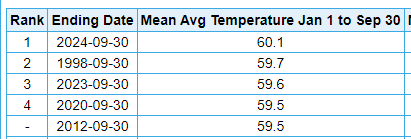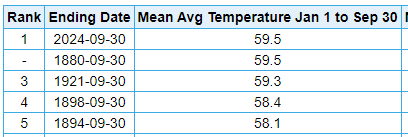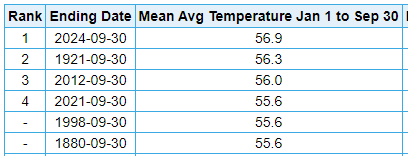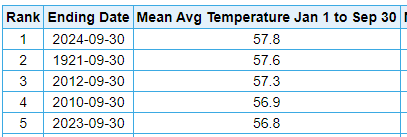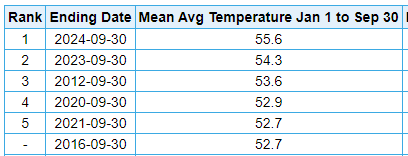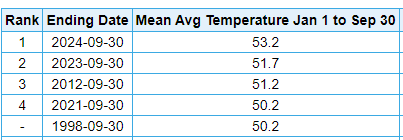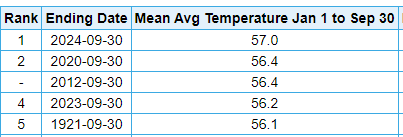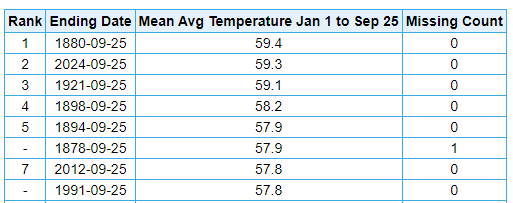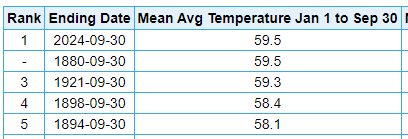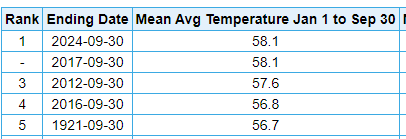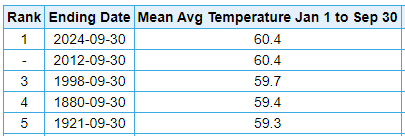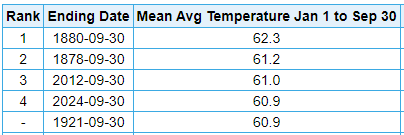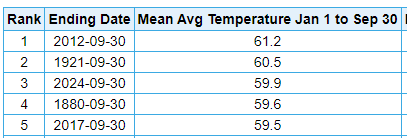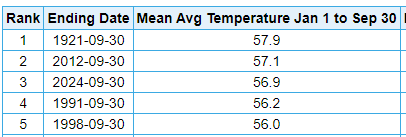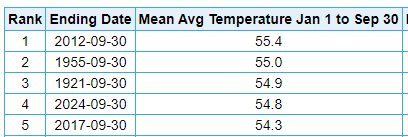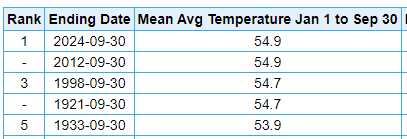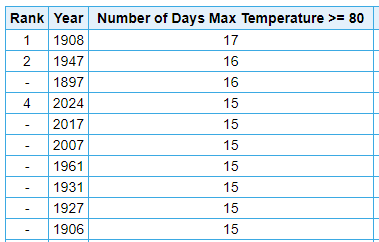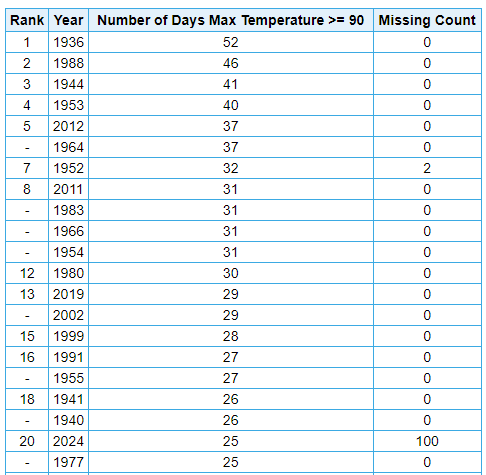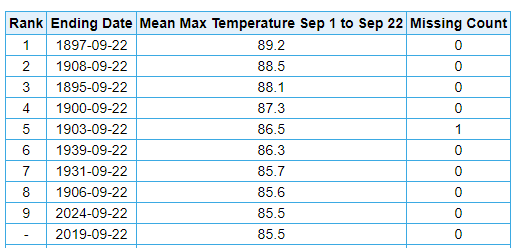
TheClimateChanger
Members-
Posts
3,941 -
Joined
-
Last visited
Content Type
Profiles
Blogs
Forums
American Weather
Media Demo
Store
Gallery
Everything posted by TheClimateChanger
-
Looks like a rather dry stretch incoming for most.
-
Occasional Thoughts on Climate Change
TheClimateChanger replied to donsutherland1's topic in Climate Change
-
Occasional Thoughts on Climate Change
TheClimateChanger replied to donsutherland1's topic in Climate Change
Does NCEI's Climate at a Glance load for anyone? I always have trouble accessing it. -
Central PA Autumn 2024
TheClimateChanger replied to Itstrainingtime's topic in Upstate New York/Pennsylvania
To be clear, 2024 alone is incredible. But the two-year punch of 2023 & 2024 is unlike anything in recorded history - and some locations have data going back more than 150 years. Just unreal. -
Central PA Autumn 2024
TheClimateChanger replied to Itstrainingtime's topic in Upstate New York/Pennsylvania
Truly historic warmth in the Commonwealth. Hard to imagine anything warmer than this in western and central Pennsylvania. That 55.6F at Jefferson County Airport [1800' elev] is warmer than 11 years in Philadelphia, despite the latter being near sea level in the far southeast corner of the State and a notorious urban heat island. Harrisburg Pittsburgh *Data before 7/1935 was taken from a substantially lower elevation in the city. Erie Williamsport Scranton/Wilkes-Barre DuBois Bradford -
Pittsburgh, PA Fall 2024 Thread
TheClimateChanger replied to TheClimateChanger's topic in Upstate New York/Pennsylvania
-
Heading into the last quarter of the year. 2024 shaping up to be a very historic year on the weather front in the GL/OV. Cleveland, Ohio Columbus, Ohio Cincinnati, Ohio *Records from 1878, 1880 downtown at low elevation. 1921 from Abbe Observatory. Detroit, Michigan Indianapolis, IN South Bend, IN Lansing, MI Saginaw, MI
-
Central PA Autumn 2024
TheClimateChanger replied to Itstrainingtime's topic in Upstate New York/Pennsylvania
-
Pittsburgh, PA Fall 2024 Thread
TheClimateChanger replied to TheClimateChanger's topic in Upstate New York/Pennsylvania
What happened to @TimB? Did he get banned? -
September 2024 General Discussion
TheClimateChanger replied to Geoboy645's topic in Lakes/Ohio Valley
At the airport. It looks like there was one instance of 17 days in the threaded record - 1908. Sounds like a reasonable figure - Detroit had 15, and Chicago 16 days that month. Still a very solid number for September. For context, 42 Augusts and 18 Julys have had 16 or fewer 80+ days at Grand Rapids. -
Occasional Thoughts on Climate Change
TheClimateChanger replied to donsutherland1's topic in Climate Change
-
September 2024 General Discussion
TheClimateChanger replied to Geoboy645's topic in Lakes/Ohio Valley
For context, at Minneapolis, there have been 45 [of 152] Julys with 19 or fewer 80+ days, being nearly 30% of all historic Julys, and 91 [of 152] Augusts with 19 or fewer 80+ days, being nearly 60% of all historic Augusts. On the low end, July 1992 had only 3 such days and August 1912, 6. In the entire meteorological summer of 1904, there were only 19 such days. And July and August each have an extra day on September. And I get a weenie for calling September the newest summer month. Prior to 2000, the ratios are even worse. 43 [of 127] Julys, or more than 1/3 of 18th and 19th century Julys. And 79 [of 127] Augusts, or 62.2% of the time. Sorry but September increasingly holds it own against past Julys and Augusts. Is it breaking down heat records from those months? No. But it is within the historical climatology of those months. -
Occasional Thoughts on Climate Change
TheClimateChanger replied to donsutherland1's topic in Climate Change
Funny, the so-called "skeptics" [i.e., deniers] don't believe recent OBSERVED temperatures, but 100% believe some BS temperature reconstruction of 500 million years ago. What a joke! -
Pittsburgh, PA Fall 2024 Thread
TheClimateChanger replied to TheClimateChanger's topic in Upstate New York/Pennsylvania
September has been another warm month. 16th warmest in the threaded record, but only 2015, 2016 & 2018 have been warmer since 1931. Could vary a bit prior to the end of the month on Monday, but given the current forecast should finish very near the current value of 69.4F. -
Pittsburgh, PA Fall 2024 Thread
TheClimateChanger replied to TheClimateChanger's topic in Upstate New York/Pennsylvania
And actually 1921 was not particularly warm the last three months of the year. Compared to the current 1991-2020 mean at PIT, October was +0.7F, November +2.1F, and December +0.3F. So only a bit above normal. A very warm October could almost seal up the warmest year on record, barring a major cold outbreak in November or December [because at that point November & December could probably run even slightly below normal and 2024 would still wind up #1]. -
Pittsburgh, PA Fall 2024 Thread
TheClimateChanger replied to TheClimateChanger's topic in Upstate New York/Pennsylvania
Also haven't looked at this in a few weeks, but PIT is now just 0.1F below the warmest YTD in the threaded record. Obviously, the older records are from the city station. And the 19th century records seem to have had some sort of warm bias on top of that, particularly in the warm season. But despite any biases, right in the mix for the record warm annual mean temperature. 1880 was not warm for the last 3 months of year so it falls off pretty rapidly. 1921 is actually the current record year in the threaded record, and 2024 has been 0.2F above that year to date. -
Pittsburgh, PA Fall 2024 Thread
TheClimateChanger replied to TheClimateChanger's topic in Upstate New York/Pennsylvania
If October, the Euro AIFS has a pretty warm looking pattern across the eastern U.S. after a cooler start to the month behind Helene. CPC agrees with increased odds of warmer than normal almost coast to coast. Not sure it will be a blowtorch, but I think odds are certainly in favor of another at least somewhat warmer than normal month. -
Pittsburgh, PA Fall 2024 Thread
TheClimateChanger replied to TheClimateChanger's topic in Upstate New York/Pennsylvania
I don't know what the weather app was looking at. There hasn't been a day within 5F of normal since the 11th. Looks like we may see a few seasonable or somewhat cooler than normal days as we head into early October, behind Helene's remnants. -
Pittsburgh, PA Fall 2024 Thread
TheClimateChanger replied to TheClimateChanger's topic in Upstate New York/Pennsylvania
September? Considering its 3.5F above normal, it's going to be closer to +5F than normal. Or was this meant to ask about the upcoming October? -
September 2024 General Discussion
TheClimateChanger replied to Geoboy645's topic in Lakes/Ohio Valley
Dayton has had 25 days of 90F or better temperatures this year. At the airport site, only 19 years [in 90 years of records] had more. Not a bad number. Would only be expected to be exceeded in about 1 of every 4 to 5 years based on historical records. No doubt being situated at 1,000+ feet helps keep these down. The 49 observed at Hamilton (Butler County) [elevation: 600 feet] is probably more representative of the conditions in the city of Dayton and the Miami River valley. -
September 2024 General Discussion
TheClimateChanger replied to Geoboy645's topic in Lakes/Ohio Valley
Similar story in Chicagoland, where the mean high temperature has been the 5th warmest in the threaded record. -
September 2024 General Discussion
TheClimateChanger replied to Geoboy645's topic in Lakes/Ohio Valley
September off to an absolutely scorching start in the Ohio Valley. Really living up to its billing as the new summer month. The first 22 days of the month have been warmer than the vast majority of Julys based on average high temperature! Columbus, Ohio Dayton, Ohio Threaded Record: At the airport site: Findlay, Ohio -
Occasional Thoughts on Climate Change
TheClimateChanger replied to donsutherland1's topic in Climate Change
Really helps to highlight the dirty little secret that nobody is allowed to utter. Contrary to "The Narrative" (TM), NOAA's temperature data consistently WARMS the PAST and COOLS the PRESENT when it comes to the highest quality stations - i.e., WBAN stations that have always observed on midnight-to-midnight days and have always been manned by meteorologists and/or trained observers from the army or navy. Too frequently this is hand-waved away by claiming it's due to the urban heat island effect due to these stations typically [but not always] being located in or near cities. Just look at the Del Rio graph. They tacked on 2F or more to all the early data - the handful of years in the early 1950s, and even into the colder summers in the 1970s - despite all of the data from the 1960s and 1970s being from the same location. And as @donsutherland1points out there's little evidence of explosive growth and urbanization driving these trends. So, what is the reason for the adjustments? I suspect it's largely due to pairwise homogenization, which is fine and dandy. But isn't a serious problem when a subset of the data (WBAN data) - and I would argue the superior quality data - has a trend that substantially deviates from the whole of the data? -
September 2024 General Discussion
TheClimateChanger replied to Geoboy645's topic in Lakes/Ohio Valley
Running the same analysis at Chicago. The current streak of 80F+ readings is up to 12 days, which is tied for 92nd longest [of any time of the year] and is forecast to reach 13 days [which would be tied for 75th longest at any time of the year]. As far as September is concerned at Chicago. The latest streaks of 10 or more days at or above 80F are: 13 days, ending 9/13/2005 [being the last 13 days of a 20-day streak]; 12 days, ending 9/15/1978; and 10 days, ending 9/17/1952, 9/10/2002 [last 10 days of a 12-day streak] and 9/10/1971 [last 10 days of a 13-day streak]. 34 days, ending 9/6/1995 [4th longest of all time] 24 days, ending 9/5/1983 [14th longest of all time] 20 days, ending 9/13/2005 20 days, ending 9/6/1980 19 days, ending 9/8/1960 15 days, ending 9/3/1953 13 days, ending 9/10/1971 12 days, ending 9/20/2024 [ongoing] 12 days, ending 9/10/2002 12 days, ending 9/15/1978 12 days, ending 9/5/1973 12 days, ending 9/4/1889 11 days, ending 9/8/1996 11 days, ending 9/1/1969 11 days, ending 9/4/1937 10 days, ending 9/4/1966 10 days, ending 9/3/1961 10 days, ending 9/17/1952 10 days, ending 9/9/1922


